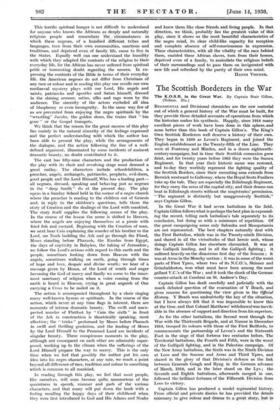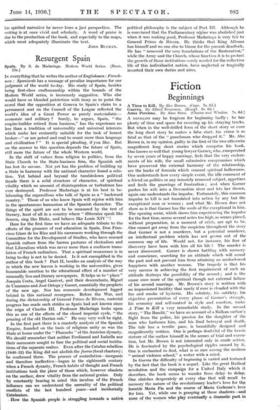The Scottish Borderers in the War
The K.O.S.B. in the Great War. By Captain Stair Gillon. (Nelson. 21s.) REGIMENTAL and Divisional chronicles are the raw material out of which a general history of the War must be built, for they provide those detailed accounts of operations from which the historian makes his synthesis. Happily, since 1918 many excellent pieces of work have been done in this sphere, and none better than this book of Captain Gillon's. The King's Own Scottish Borderers well deserve a history of their own. They began in 1689 as Leven's Regiment, and joined the English establishment as the Twenty-fifth of the Line. They were at Fontenoy and Minden, and in a dozen eighteenth- century campaigns, but in time their Scottish connexion grew faint, and for twenty years before 1805 they were the Sussex Regiment. In that year their historic name was restored, and to-day they worthily represent the fighting quality of the Scottish Borders, since their recruiting area extends from Berwick westward to Galloway, where the Royal Scots Fusiliers take up the tale. They are especially the Edinburgh Regiment, for they carry the arms of the capital city, and their drums can beat in Edinburgh streets without the magistrates' permission. " The regiment is distinctly but unaggressively Scottish," says Captain Gillon.
In the Great War it had seven battalions in the field. Captain Gillon follows what is perhaps the best plan in expound- ing the record, telling each battalion's tale separately to its conclusion, but doing so with a minimum of repetition. Of the great campaigning areas only Salonika and Mesopotamia are not represented. The best chapters naturally deal with the First Battalion, which was in the Twenty-ninth Division, and shared in all the vicissitudes of that heroic unit, whose doings Captain Gillon has elsewhere chronicled. It was at the Gallipoli landing, and in all the Gallipoli fighting ; it . suffered heavily on the disastrous first day of the Somme ; it was at Arms in the Monchy section ; it was in some of the worst, parts of First Ypres, where two of its N.C.O.'s, Skinner and Grimbaldeston, won what must have been among the most gallant V.C.'s of the War ; and it took the shock of the German. counter-attack at Cambrai on St. Andrew's Day.
Captain Gillon has dealt carefully and judicially with the much debated question of the evacuation of Y Beach, and' gives reasons for questioning the view given in the Official history. Y Beach was undoubtedly the key of the situation, but I have always felt that it was impossible to know this at the time, and that Colonel Matthews' withdrawal was inevit- able in the absence of support and direction from his superiors.
As for the other battalions, the Second went through the War with the Thirteenth Brigade, and at Namur in December 1918, trooped its colours with those of the First Bedfords, to commemorate the partnership of Leven's and the Sixteenth Foot in the siege of that fortress two centuries before. The Territorial battalions, the Fourth and Fifth, were in the worst of the Gallipoli fighting, and in the Palestine campaign. Of the New Army battalions, the Sixth was in the Ninth Division at Loos and the Somme and Arras and Third Ypres, and shared in the glory of that Division's defence as the link between Generals Gough and Byng in the German advance of March, 1918, and in the later stand on the Lys ; the Seventh and Eighth battalions, afterwards merged in one, followed the brilliant fortunes of the Fifteenth Division from toos to victory.
Captain Gillon has produced a model regimental history. FrOm official and private diaries he has provided the details xx,eoessary to give colour - and -drama to a great story, but in his spirited narrative he naver- loies a fast perspeetive. The writing is at once vivid and scholarly. A word of praise is due to the production of the book, and especially to the maps, which most adequately illuminate the text.
JOHN BUCHAN.



































 Previous page
Previous page